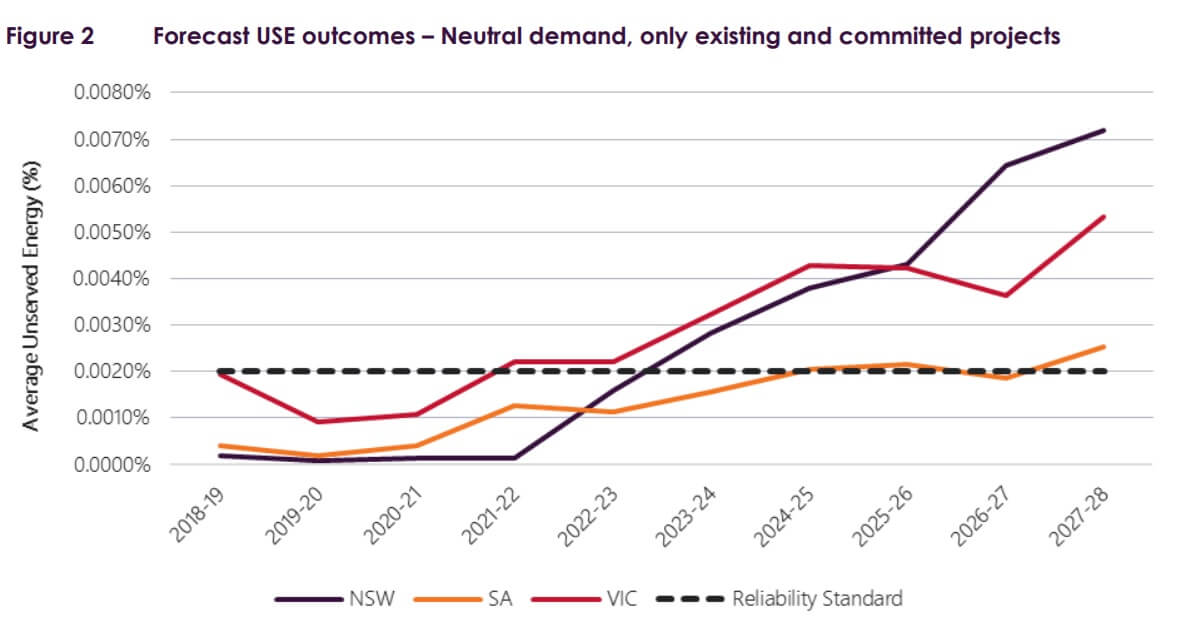The Australian Energy Market Operator has sounded the alarm over potential blackouts in Victoria this summer if nothing is done to ensure security of electricity supply.
Furthermore Victoria, New South Wales and South Australia will all be at risk of blackouts within six years if nothing is done to rectify the situation, AEMO has warned. Queensland and Tasmania are not at risk of blackouts within the next 10 years.
The findings were made in AEMO’s latest Electricity Statement of Opportunities report.
AEMO said that if no precautionary measures are taken Victoria faced a one in three chance of a blackout as Australia heads toward another record-breaking hot Summer.

The medium-term forecast shows the risk dropping off, but returning in the Summer of 2020-21 in all Australian states forming part of the National Energy Market.
AEMO warned that if nothing is done to safeguard against increased energy consumption, ageing infrastructure and deterioration of the network, the situation will spiral out of control by the year 2023-24.
The grid is designed to serve 99.998 per cent of demand, but during peak demand times and extreme weather the system is pushed to its limits and failure may occur. The projected risk is driven partly by the reduced reliability of ageing generators observed in recent years.
The electricity grid operator added that NSW faced blackouts and low power from 2023, and South Australia in 2024.
This article breaks down the NEM state by state examining potential blackouts. The report is based on a ‘do nothing’ approach, factoring in existing and committed energy generation plants.
Real-time energy mix
Victoria – 31% chance of blackouts this summer
The situation in Victoria is simple to explain. Summer 2018 is expected to be a record-breaking one for sustained heat and harsh heat waves, pushing demand for power up drastically.
This is compounded by the fact that there were 100 power station trips nationwide and that 1,200 MW of capacity was withdrawn from the state after the closure of Hazelwood in 2017.
AEMO said that if nothing is done to avert the shortfall, temperatures of 40 degrees or more in Victoria could be the catalyst for extreme, one-in-10-year demand conditions.
To avert potential load-shedding incidents, the Energy Market Operator is working with the Victorian government and major power users to ensure greater control of electricity during peak usage times.
The approach is the same as the one taken in 2017. The report said that after the upcoming summer, about 5.6 gigawatts of new wind, solar and storage capacity coming online in Victoria under the Victorian Renewable Energy Target, as well as power plant upgrades, would reduce risks of major blackouts.
This increase of supply would bring Victoria under the stability threshold until 2021 when it would face risks once more through to 2023. The risk would double by 2024-25 and climb again to 00.50% by 2027-28.
Without additional reserves, the projected risk of a shortfall in Victoria in 2018-19 is 31%, with potential blackouts typically occurring in January and February between 4 pm and 7 pm. The majority of forecast load-shedding events would be less than 500 MW and last for less than four hours. There is a 20% likelihood that Victoria will exceed the reliability standard this summer.
NSW – 8% chance of load shedding this summer
New South Wales has the most stable medium-term energy future due to its coal generation fleet. The chance of load shedding this summer stands at 8 percent. The state has a low risk of energy blackouts for the next four years, but its heavy reliance coal-fired power stations is a double-edged sword. New South Wales currently generates about 75 percent of its energy by burning coal.
Unsurprisingly, NSW faces potential blackouts from 2022, the same year that AGL Energy’s 500 MW coal-fired power station power plant closes down. Risk of blackouts will double by the year 2026 and will almost double again two years later.
New South Wales in particular faces risks due to the potential impact of drought, which will affect hydro generation
In particular, the potential impact of the New South Wales drought on water available for hydro generation and as cooling water for thermal generation will be closely monitored and reported in an updated Energy Adequacy Assessment Projection (EAAP) later this year. Given current weather conditions, bushfires may also threaten the power system this summer, limiting inter-regional transfer capabilities and increasing supply scarcity risks.
This summer, there is an 8% chance of load shedding, with a 2% chance of exceeding the reliability standard in New South Wales. While the modelling was made on a ‘do nothing’ approach, the New South Wales state government has identified three rural areas which it plans to turn into renewable energy hubs, with a reported $18 billion worth of private sector investment in the pipeline. To unlock this potential, NSW intends to build the necessary infrastructure to feed the electricity generated at these sites into the grid.
South Australia – 11% chance of load shedding
The forecast risk of blackouts in South Australia over the next four years is low, with an 11 percent chance in Summer 2018. This assessment does not include the impact of the temporary generators which are ‘out-of-market’ and are therefore not modelled. The withdrawal of 250 MW from South Australia this summer results in a large increase in blackout potential across both South Australia and Victoria and puts both regions at high risk of exceeding the reliability standard.
The staged retirement of Torrens Island A, beginning in 2019, is initially balanced by the entry of the Barker Inlet Power station. As the third and fourth units retire in 2020 and 2021 respectively, the level of blackout risks in South Australia is projected to begin increasing.
In the absence of new investment, the reliability standard is projected to no longer be met by 2024-25 in the Neutral scenario, and by 2022-23 in the Fast change scenario.
South Australia shares a forecast reliability gap with Victoria, with a gap of 40 MW across the two regions from 2022, increasing to 460 MW by 2028, with most risk projected to occur in summer between 6 pm and 8 pm.
In South Australia, there is an 11% chance of load shedding, with a 7% chance of exceeding the reliability standard in Summer 2018.
Queensland – negligible chance of load shedding
A negligible level of load shedding has been projected across all scenarios in Queensland, which has a surplus of capacity and a relatively large pipeline of committed and proposed renewable generation development.
The augmentations of the QNI interconnector between Queensland and New South Wales modelled in the ISP sensitivities utilise this surplus to reduce the risk of load shedding in New South Wales.
There are 1,996 MW of committed large-scale wind and solar generation projects in Queensland, in addition to a battery storage project.
Want to chat about reducing your energy spend?
If you want to take control of your energy spend by generating your own power and eliminating waste, get in touch with a Leading Edge Energy consultant today. Call us on 1300 852 770 or drop us an email on hello@leadingedgeenergy.com.au today.






